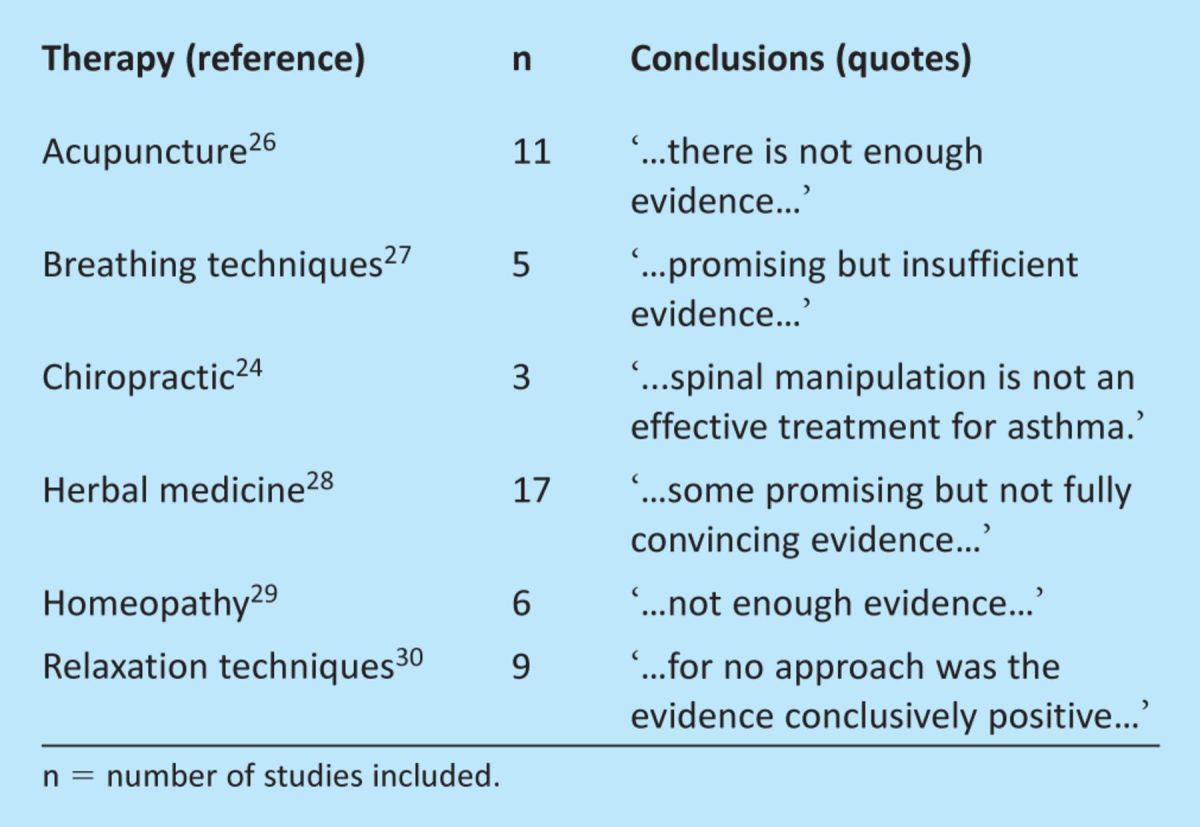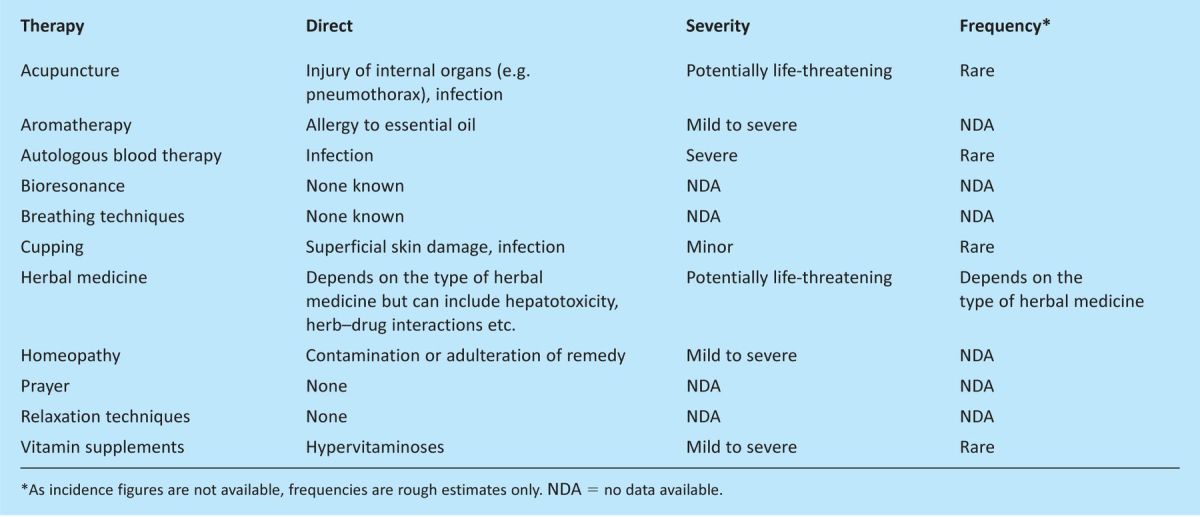Abstract
Asthma patients often try some form of alternative medicine. This article questions whether this is good or bad. Systematic reviews fail to demonstrate that the treatments in question are demonstrably effective. Other data raise considerable concern over the safety of some forms of alternative medicine. Thus the risk-benefit balance fails to be positive. Patients are often mislead to believe otherwise and physicians should inform their asthma patients responsibly about the value of alternative medicine.
Key Words: Asthma, alternative therapies, risk, safety
A large body of evidence suggests that many asthma patients use some form of alternative medicine. The precise prevalence rates vary from country to country and depend, of course, on which treatments are included under the umbrella-term of ‘alternative medicine’, but recent surveys of asthma patients have generated prevalence figures ranging from 4% to 79%.1–7 The prevalence of alternative medicine usage by paediatric asthma patients is less well researched but also seems to be high.5
Asthma patients who use alternative therapies often experience symptom reduction and less anxiety.4 They tend to use alternative therapies alongside conventional treatments and there is evidence to suggest that the use of alternative medicine does not affect adherence to conventional asthma treatments.8 The following alternative treatments seem to be particularly popular with asthma patients, but regional and other differences might exist:
aromatherapy1
autologus blood therapy9
bioresonance9
cupping11
prayer13
reflexology1
relaxation techniques4
yoga.1
Some of these interventions are self-administered, whereas others require consultations with alternative practitioners.1 There is evidence to suggest that the communication regarding alternative medicine between asthma patients and their conventional healthcare practitioners is often insufficient; many doctors fail to ask about alternative therapy usage and patients often are reluctant to volunteer this information.14
Potential for benefit
Generally speaking, the evidence supporting the effectiveness of alternative asthma therapies is less than convincing. A recent overview stated that ‘there is no strong evidence for effectiveness for any of these modalites’.6 This may well be true,15 but more differentiated judgements might be more helpful. Table 1 summarises the conclusions from systematic reviews of various alternative therapies as a symptomatic treatments for asthma. This evidence fails to suggest that treatments other than breathing techniques are effective.
Table 1.
Systematic reviews of selected alternative therapies for asthma.

Potential for harm
Considering the uncertain benefits of alternative therapies, their risks are important for determining their risk-benefit balance. In general, the risks of the above-named treatments are both under-investigated and under-reported.16 In most areas of alternative medicine, no adverse-event reporting schemes exist. Moreover, reporting of harm tends to be inadequate for clinical trials that test the efficacy of alternative asthma therapies.17 The main direct adverse effects of alternative therapies are likely to be similar, regardless of the patient's diagnosis (Table 2). A potentially important but not thoroughly investigated area is that fact that herbal and other supplements can interact with prescription drugs and thus cause adverse effects in asthma patients.18
Table 2.
Direct risks of alternative therapies.

Another important yet often neglected safety issue is that of indirect harm. If an alternative therapy that is unproven or disproven is promoted as a treatment for asthma, some patients might use it as a replacement for conventional treatment. This will result in poor clinical outcomes or, in extreme cases, deaths.
Unfortunately many alternative medicine enthusiasts fail to realise this problem, and there are many examples of unjustified claims being made, especially on the internet. In 2001, we surveyed 66 UK professional organisations of alternative practitioners.19 Our findings indicated that aromatherapists, Bowen therapists, chiropractors, homeopaths, magnet therapists, massage therapists and reflexologists all felt confident that they could treat asthma effectively. More recently, surveys of alternative practitioners or their websites suggested that ‘only a small proportion of decisions [made by these therapists] were based on evidence from clinical trials’.20,21
Chiropractic care for asthma has been relatively well researched.22 In 2003, we conducted a survey of 350 UK chiropractors to determine whether they would advise an asthma patient to try chiropractic treatment.23 The results indicated that the majority of them would recommend chiropractic treatment for asthma, despite the fact that there is evidence showing that this approach is not effective.24 The fact that doctors are often unaware of their asthma patients’ use of alternative medicine would seem to increase the risk of harm.25
Conclusions
Many asthma patients are being misled by spurious claims and thus try some form of alternative treatment. The evidence that these interventions are effective is by-and-large not convincing or even negative. Some alternative therapies are associated with significant risks. Therefore, the risk-benefit balance of these approaches is not positive. Healthcare professionals should be aware of these facts and advise their patients accordingly.
Funding
This research was funded by a fellowship from the RCP, London.
References
- 1.Knoeller GE, Mazurek JM, Moorman JE. Complementary and alternative medicine use among adults with work-related and non-work-related asthma. J Asthma 2012;49:107–13 10.3109/02770903.2011.637597 [DOI] [PubMed] [Google Scholar]
- 2.Marino LA, Shen J. Characteristics of complementary and alternative medicine use among adults with current asthma, 2006. J Asthma 2010;47:521–5 10.3109/02770900903576320 [DOI] [PubMed] [Google Scholar]
- 3.Metcalfe A, Williams J, McChesney, et al. Use of complementary and alternative medicine by those with a chronic disease and the general population —results of a national population based survey. BMC Complement Altern Med 2010;10:58. [DOI] [PMC free article] [PubMed] [Google Scholar]
- 4.Shaw A, Noble A, Salisbury C, et al. Predictors of complementary therapy use among asthma patients: results of a primary care survey. Health Soc Care Community 2008;16:155–64 10.1111/j.1365-2524.2007.00738.x [DOI] [PubMed] [Google Scholar]
- 5.Shen J, Oraka E. Complementary and alternative medicine (CAM) use among children with current asthma. Prev Med 2012;54:27–31 10.1016/j.ypmed.2011.10.007 [DOI] [PubMed] [Google Scholar]
- 6.Slader CA, Reddel HK, Jenkins CR, Armour CL, et al. Complementary and alternative medicine use in asthma: who is using what. Respirology 2006;11:373–87 10.1111/j.1440-1843.2006.00861.x [DOI] [PubMed] [Google Scholar]
- 7.Tokem Y, Aytemur ZA, Yildirim Y, Fadiloglu C. Investigation into the use of complementary and alternative medicine and affecting factors in Turkish asthmatic patients. J Clin Nursing 2011;21:698–707 10.1111/j.1365-2702.2011.03823.x [DOI] [PubMed] [Google Scholar]
- 8.Philp JC, Maselli J, Pachetr DO, Cabana MD. Complementary and alternative medicine use and adherence with pediatircs asthma treatment. Pediatrics 2012;129:e1148–54 [DOI] [PMC free article] [PubMed] [Google Scholar]
- 9.Schäfer T. Epidemiology of complementary alternative medicine for asthma and allergy in Europe and Germany. Ann Allergy Asthma Immunol 2004;93(2 Supp 1)S5–10 [DOI] [PubMed] [Google Scholar]
- 10.Torres-Llenza V, Bhogal S, Davis M, Duncharme F. Use of complementary and alternative medicine in children with asthma. Can Respir J 2010;17:183–7 [DOI] [PMC free article] [PubMed] [Google Scholar]
- 11.Cao H, Han M, Li X, et al. Clinical research evidence of cupping therapy in China: a systematic literature review. BMC Compl Alt Med 2010;10:70. 10.1186/1472-6882-10-70 [DOI] [PMC free article] [PubMed] [Google Scholar]
- 12.Akinci AC, Zengin N, Yildiz H, et al. The complementary and alternative medicine use among asthma and chronic obstructive pulmonary disease patients in the southern region of Turkey. Int J Nurs Pract 2011;17:571–82 10.1111/j.1440-172X.2011.01976.x [DOI] [PubMed] [Google Scholar]
- 13.Berkson D.The foot book. Healing the body through reflexology. New York: Barnes Noble/Harper Row, 1977 [Google Scholar]
- 14.Vacek L. Do alternative therapies complement traditional treatments of asthma? Ann Allergy Asthma Immunol 2001;86:151a [Google Scholar]
- 15.Ernst E, Pittler MH, Wider B, Boddy K.The Desktop Guide to Complementary and Alternative Medicine, 2nd edition, Edinburgh: Elsevier Mosby, 2006 [Google Scholar]
- 16.Di Stefano M, Rossi E, Baccetti S, et al. Survey on incident reporting in complementary medicine. Eur J Integr Med 2010;2:256–7 10.1016/j.eujim.2010.09.177 [DOI] [Google Scholar]
- 17.Turner LA, Singh K, Garritty C, et al. An evaluation of the completeness of safety reporting in reports of complementary and alternative medicine trials. BMC Compl Alt Med 2011;11:67. 10.1186/1472-6882-11-67 [DOI] [PMC free article] [PubMed] [Google Scholar]
- 18.Izzo AA, Ernst E. Interactions between herbal medicines and prescribed drugs: an updated systematic review. Drugs 2009;69:1777–98 [DOI] [PubMed] [Google Scholar]
- 19.Long L, Huntley A, Ernst E. Which complementary and alternative therapies benefit which conditions? A survey of the opinions of 223 professional organisations. Complementar Ther Med 2001;9:178–85 [DOI] [PubMed] [Google Scholar]
- 20.Leach MJ, Gillham D. Are complementary practitioners implementing evidence based practice. Complement Ther Med 2011;19:128–36 10.1016/j.ctim.2011.04.002 [DOI] [PubMed] [Google Scholar]
- 21.Caulfield T, Rachul C. Supported by science?: what Canadian naturopaths advertise to the public. Allergy Asthma Clin Immunol 2011;15:14. 10.1186/1710-1492-7-14 [DOI] [PMC free article] [PubMed] [Google Scholar]
- 22.Ernst E, Gilbey A. Chiropractic claims in the English-speaking world. New Zealand Med J 2010;123:36–44 [PubMed] [Google Scholar]
- 23.Schmidt K, Ernst E. Letter to the Editor: Are asthma sufferers at risk when consulting chiropractors over the Internet. Respiratory Med 2003;97:104–5 [DOI] [PubMed] [Google Scholar]
- 24.Ernst E. Spinal manipulation for asthma: a systematic review of randomised clinical trials. Respiratory Med 2009;103:1791–5 10.1016/j.rmed.2009.06.017 [DOI] [PubMed] [Google Scholar]
- 25.Frieri M. Herbal therapies: what allergist-immunologists should know regarding patient use of complementary and alternative medicine. Allergy Asthma Proc 2001;22:209–15 [PubMed] [Google Scholar]
- 26.McCarney RW, Brinkhaus B, Lasserson TJ, Linde K. Acupuncture for chronic asthma. Cochrane Database of Syst Rev 2003. Issue 3, Art No: CD000008 10.1002/14651858.CD000008.pub2 [DOI] [PMC free article] [PubMed] [Google Scholar]
- 27.Ernst E. Breathing techniques—adjunctive treatment modalities for asthma? A systematic review. Eur Respir J 2000;15:969–72 [DOI] [PubMed] [Google Scholar]
- 28.Huntley A, Ernst E. Herbal medicines for asthma: a systematic review. Thorax 2000;55:925–9 10.1136/thorax.55.11.925 [DOI] [PMC free article] [PubMed] [Google Scholar]
- 29.McCarney RW, Linde K, Lasserson TJ. Homeopathy for chronic asthma. Cochrane Database of Systematic Reviews 20041)CD000353. 10.1002/14651858.CD000353.pub2 [DOI] [PMC free article] [PubMed] [Google Scholar]
- 30.Huntley A, White AR, Ernst E. Relaxation therapies for asthma: a systematic review. Thorax 2002;57:127–31 10.1136/thorax.57.2.127 [DOI] [PMC free article] [PubMed] [Google Scholar]


